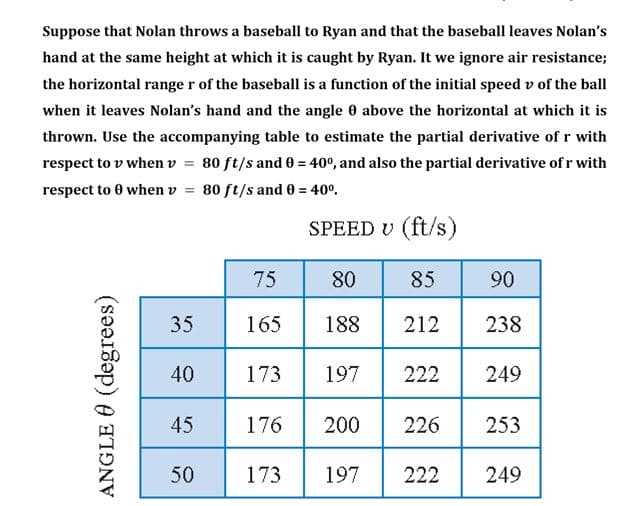Suppose that Nolan throws a baseball to Ryan and that the baseball leaves Nolan's hand at the same height at which it is caught by Ryan. It we ignore air resistance; the horizontal range r of the baseball is a function of the initial speed v of the ball when it leaves Nolan's hand and the angle 0 above the horizontal at which it is thrown. Use the accompanying table to estimate the partial derivative of r with respect to v when v = 80 ft/s and 0 = 40°, and also the partial derivative of r with %3D respect to 0 when v 80 ft/s and 0 = 40°. %3! SPEED ν (ft/s ) 75 80 85 90 35 165 188 212 238 40 173 197 222 249 45 176 200 226 253 50 173 197 222 249 ANGLE O (degrees)
Suppose that Nolan throws a baseball to Ryan and that the baseball leaves Nolan's hand at the same height at which it is caught by Ryan. It we ignore air resistance; the horizontal range r of the baseball is a function of the initial speed v of the ball when it leaves Nolan's hand and the angle 0 above the horizontal at which it is thrown. Use the accompanying table to estimate the partial derivative of r with respect to v when v = 80 ft/s and 0 = 40°, and also the partial derivative of r with %3D respect to 0 when v 80 ft/s and 0 = 40°. %3! SPEED ν (ft/s ) 75 80 85 90 35 165 188 212 238 40 173 197 222 249 45 176 200 226 253 50 173 197 222 249 ANGLE O (degrees)
Calculus: Early Transcendentals
8th Edition
ISBN:9781285741550
Author:James Stewart
Publisher:James Stewart
Chapter1: Functions And Models
Section: Chapter Questions
Problem 1RCC: (a) What is a function? What are its domain and range? (b) What is the graph of a function? (c) How...
Related questions
Question

Transcribed Image Text:Suppose that Nolan throws a baseball to Ryan and that the baseball leaves Nolan's
hand at the same height at which it is caught by Ryan. It we ignore air resistance;
the horizontal range r of the baseball is a function of the initial speed v of the ball
when it leaves Nolan's hand and the angle 0 above the horizontal at which it is
thrown. Use the accompanying table to estimate the partial derivative of r with
respect to v when v = 80 ft/s and 0 = 40°, and also the partial derivative of r with
respect to 0 when v = 80 ft/s and 0 = 40°.
%3D
SPEED v (ft/s)
75
80
85
90
35
165
188
212
238
40
173
197
222
249
6 200
45
176
226
253
50
173
197
222
249
ANGLE O (degrees)
Expert Solution
This question has been solved!
Explore an expertly crafted, step-by-step solution for a thorough understanding of key concepts.
This is a popular solution!
Trending now
This is a popular solution!
Step by step
Solved in 2 steps with 2 images

Knowledge Booster
Learn more about
Need a deep-dive on the concept behind this application? Look no further. Learn more about this topic, calculus and related others by exploring similar questions and additional content below.Recommended textbooks for you

Calculus: Early Transcendentals
Calculus
ISBN:
9781285741550
Author:
James Stewart
Publisher:
Cengage Learning

Thomas' Calculus (14th Edition)
Calculus
ISBN:
9780134438986
Author:
Joel R. Hass, Christopher E. Heil, Maurice D. Weir
Publisher:
PEARSON

Calculus: Early Transcendentals (3rd Edition)
Calculus
ISBN:
9780134763644
Author:
William L. Briggs, Lyle Cochran, Bernard Gillett, Eric Schulz
Publisher:
PEARSON

Calculus: Early Transcendentals
Calculus
ISBN:
9781285741550
Author:
James Stewart
Publisher:
Cengage Learning

Thomas' Calculus (14th Edition)
Calculus
ISBN:
9780134438986
Author:
Joel R. Hass, Christopher E. Heil, Maurice D. Weir
Publisher:
PEARSON

Calculus: Early Transcendentals (3rd Edition)
Calculus
ISBN:
9780134763644
Author:
William L. Briggs, Lyle Cochran, Bernard Gillett, Eric Schulz
Publisher:
PEARSON

Calculus: Early Transcendentals
Calculus
ISBN:
9781319050740
Author:
Jon Rogawski, Colin Adams, Robert Franzosa
Publisher:
W. H. Freeman


Calculus: Early Transcendental Functions
Calculus
ISBN:
9781337552516
Author:
Ron Larson, Bruce H. Edwards
Publisher:
Cengage Learning